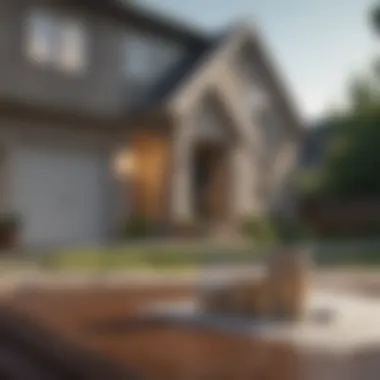Financial Aspects of Buying a 200K Home


Intro
Buying a home is often one of the most significant financial decisions in a person's life. For those considering a property in the vicinity of $200,000, understanding the full spectrum of costs involved is crucial. From the moment you think about making that purchase, you need to be ready for more than just the sticker price of the house. It implies a deep dive into financial nuances that often go unnoticed. This article aims to break down these considerations, arming prospective homeowners and investors with the knowledge to navigate this often tumultuous market.
Investment Terminology
Definition of Key Terms
Understanding real estate terminology is imperative for making informed decisions. Below are a few key terms that will be utilized throughout this article:
- Mortgage: A loan specifically for purchasing property, secured by the property itself.
- Escrow: A financial arrangement where a third party holds funds on behalf of the buyer and seller until certain conditions are met.
- Closing Costs: A collection of fees paid at the closing of a real estate transaction, which can include appraisal fees, title insurance, and attorney fees.
Explanation of Complex Concepts
When venturing into the realm of home buying, certain concepts can seem daunting.
- Amortization: This is the process through which loan payments are structured to pay down both interest and principal over time, affecting the overall cost of the mortgage. Many find it beneficial to familiarize themselves with an amortization schedule to gauge how much of their monthly payment goes towards principal versus interest.
- Equity: This represents the portion of the home that you own outright. For instance, if your 200K home appreciates to 250K and you've paid off some of your mortgage, the difference between the current market value and the remaining mortgage balance is your equity. Growing equity can serve as a financial cushion or a means to secure loans in the future.
Financial Considerations
Acquiring a $200,000 home requires a well-rounded understanding of the finances at play. Let's lay out the significant costs involved, aside from the mortgage payment itself.
- Property Taxes: Homeownership comes with added responsibilities, including paying property taxes. In many regions, this can range significantly. It’s not just a one-time fee but an ongoing yearly expense.
- Homeowners Insurance: Protecting your investment is crucial, and getting proper coverage can cost between hundreds to thousands of dollars annually depending on factors like location and home value.
- Maintenance Costs: Properties require upkeep. From roof repairs to routine plumbing service, having a budget for these can save you from unexpected financial strain.
A potential buyer, when contemplating the long-term financial implications of purchasing a home, should put pen to paper, or better yet, use a budget planner. This will not just highlight monthly mortgage payments but encapsulate all costs associated with keeping the roof over their head.
"A home is not just a place; it’s an ongoing investment. Keeping your financial lenses clear will ensure that investment isn’t just a burden but a beneficial step forward in your personal wealth journey."
Expert Advice
For those who might feel jaded by the process, remember that there’s wisdom to be found in the voices of those who’ve gone before. Seeking out expert advice can pave a clearer path.
Best Practices for Investment
- Get Pre-Approved for a Mortgage: This helps you understand how much you can borrow and what your future mortgage payments may look like. This crucial first step puts you in a stronger negotiating position.
- Consider Location, Location, Location: Real estate is all about the three L’s. An area on the uptrend can turn a house into a lucrative investment over time.
- Don't Skip Inspections: Whether you're handy or not, having a professional inspector evaluate the house can safeguard you from hidden problems.
Tips from Financial Experts
- Calculate Total Costs: Before making offers, ensure you've accounted for every expense—this way you’re never left with a surprise bill.
- Diversify Your Portfolio: If real estate is your focus, consider how it fits into your overall investment strategy. Don’t put all your eggs in one basket, especially in fluctuating markets.
In sum, embarking on the homes-buying journey, especially with a budget around $200,000, necessitates acute financial awareness and strategic planning. As you delve deeper into the particulars of closing the deal, remember that each step is a part of a larger investment strategy that impacts your financial future.
Understanding Home Purchase Costs
When embarking on the significant journey of acquiring a home, particularly one valued at $200,000, grasping the financial implications surrounding home purchase costs is foundational. This segment sets the stage for a nuanced inquiry into expenses often overlooked in the excitement of home buying. Knowing these intricacies can prevent unwelcome surprises down the road and ensure a smooth transition into homeownership.
Understanding home purchase costs encompasses a variety of elements. It’s not just about the sticker price; additional financial commitments are lurking beneath the surface and can accumulate swiftly. By arming yourself with knowledge of these expenses, you engage in a well-rounded decision-making process, aiding both novice homebuyers and seasoned investors in their quest.
Overview of Home Buying Expenses
Home buying expenses fill a broad spectrum beyond the mere price posted on a listing. It’s akin to peeling an onion—layer upon layer reveals more costs. Here’s a rundown of key areas you should be aware of:
- Down Payments: This initial outlay can typically range from 3% to 20% of the home’s purchase price, directly impacting how much you’ll need to save initially.
- Closing Costs: These range typically from 2% to 5% of the home’s price and include fees for appraisals, title insurance, inspections, and lender fees.
- Homeowners Insurance: A must-have when financing a property, its cost varies based on location and home value.
- Property Taxes: These are recurring expenses that can change annually, depending on the local government's assessments and regulations.
Conclusively, it's essential to tally these costs to obtain a realistic picture of what the true cost of acquiring a home entails. Not accounting for these may lead to severe budget constraints that can derail your financial planning.
The Significance of the Principal Amount
At the heart of home buying lies the principal amount, which is the total money borrowed from the lender to purchase the property. This number is not just an arbitrary figure; it dictates your mortgage calculations and final payment obligations. Understanding its significance can illuminate the long-term financial commitments tied to homeownership.
For instance, if you purchase a $200K house with a 20% down payment of $40,000, your mortgage loan would be $160,000. Each payment encompasses both the principal and the interest charged by the lender. Higher principal means higher monthly payments, and understanding this dynamic can guide buyers in selecting the right home and loan product that aligns with their financial capabilitites.
In short, before signing on the dotted line, it is crucial to calculate how these principal amounts will fit into long-term financial strategies to ensure sustainable homeownership.
"Being aware of the significance of the principal amount and its influence on costs can prevent future financial missteps."
A comprehensive understanding of home purchase costs encourages better financial decisions and prepares you for the fruitful journey of homeownership, allowing for a solid foundation upon which to build your future.
Down Payment Considerations
When stepping into the world of homeownership, down payments often take center stage in financial discussions. The down payment isn't just a mere formality; it's a crucial component that lays the groundwork for your mortgage agreement and ultimately influences your financial journey. A larger down payment often leads to lower monthly payments, reduced interest rates, and fewer overall costs. However, dipping too deep into your savings for that initial payment can throw your overall financial strategy off balance.
Exploring Typical Down Payment Rates


In the realm of home buying, the typical down payment rate can vary significantly based on individual circumstances and lender requirements. Many first-time buyers tend to settle around the 20% mark, especially to avoid private mortgage insurance, or PMI. However, some buyers may opt for lower percentages, sometimes as little as 3% or 5% with certain loan programs.
Consider the advantages of different down payment rates:
- 20% Down: Avoids PMI, provides equity from day one, and likely offers better terms on the mortgage.
- 10% Down: More manageable for some buyers while still reducing PMI costs.
- 3-5% Down: Attractive for first-time buyers, allowing entry into the housing market sooner but often incurs PMI.
Each of these options comes with its own set of pros and cons. It's wise to calculate your budget thoroughly and examine what’s truly feasible in your unique financial situation.
Impact of PMI on Initial Investment
Private Mortgage Insurance (PMI) plays a significant role when you can't muster a hefty down payment. This insurance protects lenders from the additional risk they take when lending to borrowers who cannot put down a significant amount upfront. If you put down less than 20%, PMI becomes an involuntary line item on your monthly mortgage bills.
The costs associated with PMI vary, but here's a rough breakdown of how it can play out:
- Cost of PMI: This typically ranges from 0.3% to 1.5% of the original loan amount annually. On a $200,000 home, this could mean an additional $600 to $3,000 a year.
- Monthly Impact: Monthly PMI payments can add around $50 to $200 to your mortgage payment.
PMI can be a double-edged sword. While it allows you to enter homeownership sooner, it also inflates your future mortgage payments. Understanding this impact is paramount when deciding your down payment strategy. Ultimately, balancing the desire for immediate homeownership against the long-term financial implications will set the stage for a more informed decision.
"The initial investment in a home goes beyond just the down payment. Understanding each piece of the financial puzzle is crucial for long-term success in real estate."
Whether you're a seasoned buyer or diving into this realm for the first time, these insights can help navigate the waters of down payments and their lasting implications on your financial landscape.
Mortgage Options and Their Influence
When considering the purchase of a $200,000 home, the choice of mortgage is pivotal. It not only shapes your monthly payment but also influences your overall financial landscape. By understanding the different types of mortgage options, potential homebuyers can make informed decisions that align with their long-term financial goals.
Choosing Between Fixed and Variable Rates
One of the first decisions to tackle is whether to go with a fixed or variable rate mortgage. A fixed-rate mortgage ensures that your interest rate and monthly payments remain constant over the life of the loan. This can bring a sense of stability, giving buyers peace of mind amidst fluctuating market conditions. For example, if you lock in a rate of 3.5%, that will not change for the duration of your 30-year loan, which simplifies budgeting.
On the other hand, a variable rate mortgage, also known as an adjustable-rate mortgage (ARM), starts with a lower interest rate, but it can change periodically based on market rates. This means that while your initial payments might be lower, there’s a gamble involved. If market rates increase, your payments could rise significantly over time. For instance, someone who gets an initial rate of 2.5% may find that after five years, their rate adjusts to 4.0% or higher, possibly doubling their monthly payment.
"Choosing the right type of mortgage can be the difference between financial security and fiscal strain."
Deciding between fixed and variable requires careful reflection on your risk tolerance and financial situation. If you plan to stay in your home for the long haul, a fixed rate might serve you better. Conversely, if you’re looking to sell or refinance in a few years, an ARM might save you money upfront.
Loan Term Lengths and Financial Impact
Next, the term length of your mortgage plays a crucial role in your finances. Common options include 15-year, 20-year, and 30-year mortgages. Each choice comes with its unique implications for your financial health.
A 30-year mortgage is popular among first-time buyers because it spreads payments over a longer period, keeping them low. This can make homeownership more accessible, especially when it comes to a $200,000 purchase where monthly payments must fit into a budget. However, the downside is that longer terms usually mean paying much more in interest over the life of the loan.
In contrast, a 15-year mortgage demands higher monthly payments but allows you to pay off your home faster and save significantly on interest. For instance, with a $200,000 loan at a 3% interest rate, opting for a 15-year term may result in total interest costing around $40,000 versus nearly $110,000 with a 30-year term at the same interest.
In summary, your mortgage options and the term you choose will heavily influence not just your monthly budget but also the long-term costs associated with buying a home. Weighing the security of fixed rates against the variability of ARMs, combined with an understanding of how loan length can alter your fiscal commitments, is essential for navigating the mortgage landscape effectively.
Monthly Payment Breakdown
Understanding the monthly payment breakdown is crucial for anyone considering the purchase of a $200,000 home. This section is not just about identifying what you will pay each month—it's about grasping how various components contribute to your total outlay. Every dollar matters when it comes to homeownership, and knowing what these payments entail can affect your long-term financial planning.
Principal and Interest Payments
When you take out a mortgage, your monthly payment is generally split into two main parts: principal and interest. The principal refers to the loan amount borrowed from the lender, while interest constitutes the charge for borrowing that money.
As you make payments, the principal amount reduces over time. While initially, a larger portion of your payment goes toward interest, this balance gradually shifts. For example, in the early years of a 30-year fixed-rate mortgage, you might find that only a small fraction of your payment is actually bringing down the principal balance.
Here’s a breakdown of this concept with practical figures:
- Loan Amount: $200,000
- Interest Rate: 4%
- Loan Term: 30 years
Using a mortgage calculator, you can find that the principal and interest payment would be approximately $955 per month. This figure represents a significant commitment and reiterates the importance of shopping around for the best interest rate.
Understanding Property Taxes
Property taxes are another critical element of homeownership costs that flat-out cannot be ignored. Depending on the location of the home, taxes might vary widely. On average, property taxes may account for about 1.1% of the home's value per year.
For a $200,000 home, that would translate to approximately $2,200 annually, or about $183 monthly. These taxes support local services like schools, infrastructure, and emergency services. But here's a catch: if property values rise, so do the tax obligations, which can pinch your annual budget. It's wise to research the historical tax trends in the area before making a buy.
Homeowners Insurance and Its Necessity
Lastly, don't overlook homeowners insurance. This is sometimes mandated by lenders, but even without that requirement, it's a smart safeguard. This insurance covers potential damages to your property, and it protects your liability in case someone is injured on your premises.
The average cost of homeowners insurance varies, often hovering around $1,000 annually for a basic policy. That breaks down to about $83 monthly. If unforeseen circumstances occur, such as fire or water damage, this insurance could be a financial lifesaver. Let's not kid ourselves; replacing a roof or covering damage from a storm can hit hard on the wallet.


Quick tip: Always shop for homeowners insurance and consider bundled options if you have auto or other insurance needs.
Hidden Costs of Homeownership
When it comes to acquiring a home, many individuals often focus primarily on the obvious costs like down payments and monthly mortgage payments. However, the hidden costs of homeownership can sneak up and deliver quite a sting to unprepared buyers. Understanding these hidden expenses is crucial. It helps in creating a realistic budget for homeownership, ensuring that financial enthusiasts make informed decisions.
These hidden costs can significantly impact the overall financial picture for new homeowners. Knowing that it's not just about the purchase price, but also ongoing obligations, is essential for forecasting long-term financial stability.
Maintenance and Repair Expenditures
Owning a home is like having a car; regular upkeep is not a choice, it's a necessity. Home maintenance can be a considerable expense over time, and it’s one of those costs that can easily be overlooked during the home-buying process.
You can’t sidestep issues like leaky roofs, aging appliances, or seasonal HVAC tune-ups. For instance, setting aside about 1% of your home's value annually for general maintenance could be a sound guideline. For a $200,000 home, that means budgeting around $2,000 each year for repairs and upkeep.
The age and condition of your home will play a significant role in these costs. If the property is new, you might have a little breathing room, but as homes get older, repairs can pile up quicker than you might anticipate.
HOA Fees for Community Living
If your new home is part of a homeowner's association, be prepared for those monthly or annual assessments. Homeowners Association (HOA) fees can differ widely based on community amenities and services.
These dues might cover maintenance of common areas, security services, and even certain utility costs, but they can add substantially to monthly expenditures. Therefore, it's pivotal to factor in these fees while assessing your overall budget. Imagine paying $300 a month in HOA fees; that's an added $3,600 a year you must account for in your financial planning.
Utilities and Monthly Bills
Lastly, don’t underestimate the recurring costs of utilities. Electricity, water, gas, and internet – these bills are part of the package that comes with homeownership. Interestingly, utility costs vary significantly based on location, season, and even the efficiency of the home’s appliances.
A good approach is to review the previous utility bills of the home you’re considering buying. This will give you a more accurate picture of what to expect. Typically, the average household spends about $300 to $400 monthly on utilities, depending on various factors.
This insight is invaluable for budgeting purposes, preventing any unwelcome surprises once you’re settled in your new digs.
Comparative Analysis with Other Property Types
When it comes to acquiring a home, a comparative analysis with other property types proves invaluable. It empowers potential buyers to weigh their options more critically and understand what their money can buy in different situations. Not all homes are created equal. Parameters like location, property age, and type play a critical role in influencing both costs and long-term value. By exploring these facets, buyers can avoid common pitfalls and make more informed decisions.
Cost Differences for New vs. Resale Homes
Purchasing either new or resale homes comes with its own set of financial implications. New constructions often boast modern amenities and energy-efficient features, but they typically demand a premium price. The allure of a new home can be enticing, especially when owners consider the reduced need for repairs and upkeep in the initial years. However, buyers should not overlook the hidden costs associated with new builds, such as delayed completion and potential changes in design contracts.
A new house may come straight from the builder, but old houses often have charm and character that can’t be replicated.
On the flip side, resale homes can be a more budget-friendly option, and they often provide a clearer picture of the neighborhood and its dynamics. They may, however, come with repair needs and aging systems. The initial investment may be lower, but it's essential to factor in potential renovation costs. So, the decision often hinges on balancing your budget against long-term expenses, making an in-depth comparison between expected repairs and initial purchase price crucial.
Location Impact on Total Purchase Costs
Location remains a cornerstone when evaluating property types. The saying "location, location, location" rings true in real estate. Homes in metropolitan areas like Los Angeles or New York City will likely command higher prices compared to those in smaller towns or rural areas. Yet, while upfront costs might be higher, the appreciation rates in these high-demand locations may yield significant returns in the long run.
When considering a 200K home, it helps to examine other external influences:
- Proximity to schools and workplaces can spur property values.
- Accessibility to public transport can also be a game-changer in determining future value.
- Gentrification patterns might signal a bright future for a community while also indicating potential rising costs in the short term.
Local amenities can sway location desirability; restaurants, shopping areas, and parks not only enhance lifestyle but also property value in many cases.
In evaluating where to place your 200K, understanding these cost differences vs. location impacts presents a holistic view of your investment, potentially guiding you toward more lucrative choices.
Long-term Financial Planning
When it comes to purchasing a home, particularly one valued at 200k, diving into long-term financial planning emerges as a pivotal element of the overall strategy. This isn't just about crunching numbers for a mortgage or deciding how much to put down; it's about crafting a roadmap for your financial future. This section will touch on the intricate layers of financial planning that can make or break potential homeowners' financial journeys.
First and foremost, understanding the intricacies of home value appreciation can set the stage for an effective plan. In many cases, real estate tends to appreciate over time, and this can be a sweet spot for aligning your investment goals. It’s critical to analyze historical trends in your local market. The reality is, a well-timed purchase can yield remarkable returns down the road, making a 200k home not just a dwelling but an investment. If, let's say, the home appreciates at an average rate of 3% annually, a bit of math shows that the value could rise to over 250k in just a decade. Planning for such possibilities empowers homeowners and fortifies their financial standing in the long run.
Next, homeowners must not gloss over exit strategies and resale considerations. Life is inherently unpredictable—personal circumstances may change down the line. Your job could require relocation, or family dynamics might necessitate a bigger space. As a prudent homeowner, it’s wise to consider how to maximize your return on investment when it's time to sell. Knowing the local real estate market trends will help gauge the right time to sell. Factors like neighborhood developments, new schools being built, and infrastructure improvements can significantly influence resale value.
Impact of Home Value Appreciation
When evaluating the financial implications of acquiring a home, the impact of home value appreciation cannot be overstated. Homeowners often consider their purchase as a long-term investment, hence understanding how property values appreciate should play a fundamental role in their financial planning.
- Market trends: Maintain a keen eye on local market fluctuations. Areas with job growth or amenities that draw people tend to see higher appreciation rates.
- Improvements: Any renovations or improvements made to the home can boost its market value. Therefore, understanding which upgrades yield the highest returns is tactical.
Notably, it’s not solely about the market; economic factors play a substantial role here too. Interest rates and national economic health influence buyer behavior and, in turn, home values.
Exit Strategies and Resale Considerations
Planning an exit strategy for your home purchase is just as crucial as your buying decision. Knowing when and how to resell can significantly impact your financial future. Consider the following:


- Timing the market: Understanding when to sell can lead to a more substantial profit. Selling in a seller's market can mean the difference of thousands of dollars.
- Acquiring knowledge: Familiarize yourself with the resale process. This means learning about staging, closing costs, and tax implications upon selling.
- Potential buyers: Understand what draws in buyers in your area—schools, parks, shopping centers—these can make your home more attractive and command a higher resale value.
In summary, effective long-term planning extends beyond initial purchase considerations. It incorporates aspects of market appreciation as well as thoughtful exit strategies. These components play a crucial role in shaping the financial landscape for homeowners. Engaging in this holistic view allows potential buyers to create a sturdy foundation for their future.
"The best investment on Earth is earth."
– Louis Glickman
By diligently assessing these factors, buyers can navigate the often murky waters of real estate with greater confidence and foresight.
Tax Implications of Homeownership
When you own a home, you're not just making mortgage payments and dealing with roof repairs. You also step into a complex world of tax considerations that can have a significant impact on your financial situation. Understanding the tax implications of owning a home can save you money, influence your purchasing power, and guide future investment decisions. If you're diving into ownership of a 200K home, it's crucial to unpack how taxes will play a role in that decision.
Mortgage Interest Deductions
One of the most noteworthy benefits for homeowners is the mortgage interest deduction. This allowance enables you to deduct the interest paid on your mortgage from your taxable income. For a $200K home, this can amount to a substantial reduction in your tax liability, especially in the early years of the mortgage when interest payments are highest.
For instance, if you secure a mortgage at a 4% interest rate, you’d be looking at roughly $8,000 paid in interest during the first year. When you factor in the tax implications, you could potentially lower your taxable income significantly, which means you'll pay less in federal taxes. However, it’s paramount to remember:
- Limits on Deductions: The deduction applies only to interest on mortgages up to $750,000 for married couples filing jointly, and $375,000 for single filers.
- Itemization Requirement: To benefit from this deduction, you have to itemize your deductions rather than taking the standard deduction. This means weighing your total deductions carefully to see which generates the best tax advantage.
"Tax deductions can be a powerful tool, but they often come with strings attached. Always read the fine print and consult a tax professional if in doubt."
Capital Gains Tax Overview
When you eventually sell your home, understanding capital gains tax is critical. This tax is levied on the profit made from selling a property, calculated as the difference between the sell price and the purchase price. If you bought your home for 200K and sold it for 300K, you’d have a capital gain of 100K.
However, as a homeowner, you can potentially exclude a significant amount of that gain from your income:
- Exclusion Limits: For single filers, up to $250,000 of capital gains can be excluded, and for married couples filing together, the limit is $500,000. This means that a couple who bought their 200K home and sells for 700K could pocket a neat gain without paying tax on the first 500K.
- Ownership and Use Tests: The property must have been your primary residence for at least two out of the last five years. If you meet this, it can drastically change how much you owe come tax time.
Navigating these intricacies can create opportunities to maximize the benefits of homeownership while minimizing tax liabilities. Homeownership can offer long-term financial freedom and wealth building, especially when understood through the lens of taxes.
Financing Options and Resources
When it comes to purchasing a home priced at $200,000, understanding the variety of financing options available is key. Choosing the right financing route can not only ease the immediate burden of securing a mortgage but also shape one's long-term financial health. Potential homebuyers are often bombarded with different terms, rates, and loans, making it essential to take a step back and evaluate these choices carefully.
Exploring Government-backed Loans
Government-backed loans are an attractive option for many first-time buyers. These loans, which include FHA, VA, and USDA loans, guarantee a level of security, making lenders more confident in approving your application. One big appeal is that they often require lower down payments than conventional loans.
- FHA Loans: Backed by the Federal Housing Administration, FHA loans are designed for buyers with lower credit scores. With a down payment as low as 3.5%, this option opens doors for many who feel priced out of the market due to strict lending conditions.
- VA Loans: For veterans and active military personnel, VA loans stand out with zero down payment and no private mortgage insurance required. This can translate into significant savings over time, reinforcing the appeal of homeownership in military circles.
- USDA Loans: These loans support rural development and are especially beneficial for low- to moderate-income individuals. They also feature zero down payment options, catering to buyers wishing to live outside urban settings.
However, it's vital to scrutinize the eligibility requirements, as they can be quite specific. For instance, to qualify for a USDA loan, your chosen property must fall within designated rural areas and meet certain income criteria.
Private Lending Institutions: Pros and Cons
Private lenders offer another avenue for financing that can differ significantly from traditional banks. Often these institutions have more flexibility in their lending criteria, which can speed up the process for borrowers in urgent need.
Pros:
- Faster Approval: Private lenders sometimes provide quicker loan approval compared to standard processes in banks. This can be crucial if you're up against multiple offers.
- Flexible Terms: They often have more lenient guidelines regarding credit scores, allowing those with less-than-perfect credit to access home loans.
- Customizable Loan Options: Borrowers may negotiate terms that suit their unique financial situations, leading to a tailored borrowing experience.
Cons:
- Higher Interest Rates: One of the greatest disadvantages of private lending is the potential for elevated interest rates. This means higher monthly payments and more paid in interest over the loan's life.
- Less Regulation: Without the stringent regulations that govern banking institutions, the terms of private loans can sometimes be less favorable or even predatory.
- Lack of Security: If a financial strain occurs, private lenders may not offer the same support and understanding that banks do, which can heighten stress during tough times.
Understanding the nuances between different financing options helps buyers make informed decisions, potentially saving thousands over the life of a mortgage.
Researching financing thoroughly will allow homebuyers to feel confident in their decisions. By weighing the benefits and drawbacks of government-backed loans against private lending, potential homeowners can choose a financing strategy that fits their unique circumstances and financial goals. Whether leaning toward the stability of a government-backed option or the flexibility of a private lender, knowledge is the first step toward successful homeownership.
Closure: Assessing the True Cost of Homeownership
Evaluating the financial implications of acquiring a home isn't just about looking at the purchase price. When considering a $200K home, buyers should dig deeper. The expenses go beyond simple mortgage calculations and monthly payments. It’s crucial to understand that costs can creep up and surprise potential owners down the line.
One of the key takeaways here is recognizing the significance of all associated costs. Buyers need to paint a full picture of long-term commitments that come with homeownership. For instance, property taxes can fluctuate wildly depending on the local market. Crumbling roofs or leaky pipes should be on your radar, too. These hidden costs can easily derail financial stability if not accounted for from the start.
The benefits of being well-informed are numerous. A thorough understanding of the financial implications arms potential buyers with the knowledge to make more strategic decisions. It’s not just about whether you can afford the mortgage; it’s about whether you can manage the ongoing obligations that come with it.
Investing in a $200K home should not feel like a leap into the unknown. Knowledge is power, and knowing the total financial landscape can shape realistic expectations and future financial goals. This conclusion is not simply about wrapping up the discussion – it’s about emphasizing critical awareness that every potential homeowner must possess.
"A penny saved is a penny earned," and in the case of homeownership, it applies tenfold.
Final Considerations for Potential Buyers
Before diving headfirst into the housing market, there are several considerations worth taking into account.
- Establish a realistic budget: Don’t forget about costs like maintenance, insurance, and taxes. They can be more than you expect.
- Research local housing markets: Regional factors can heavily influence total expenses.
- Consult with professionals: A realtor may have insights beyond the surface-level financial details.
- Assess your personal financial situation: Look at your income, savings, and other financial commitments.
In summary, purchasing a $200K home requires a comprehensive understanding of the total costs involved. It’s essential to look beyond price tags and mortgage slips to ensure a successful and sustainable investment in one's future.







